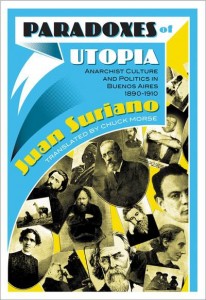[Published on December 14, 2007]
In the mid-1960s, a loose band of artists, hippies, and anarchists burst onto the political stage in the Netherlands. Known as the Provos (as in to provoke), they led a mini-rebellion against the established order that rattled elites and left behind an inspired legacy of anti-authoritarian activism.
Richard Kempton documents this legacy in his recently released, Provo: Amsterdam’s Anarchist Revolt, the first book-length history of the group in English. He traces the emergence, highpoints, and decline of the Provos, in addition to providing tangential but interesting appendices on topics such as the relationship between the Provos and the Situationists, the history of anarchism in Amsterdam, and others. He does a good job at placing the group in the context of the radical currents from which it emerged and at relating the Provos’ trajectory to some of the political peculiarities of the Netherlands. While a deeper examination of the group’s ideas and internal organization would have enriched the book, I found it to be thoughtful, informative, and fun to read. (For a quick introduction to the Provos, you may wish to check out this article as well as this one.)
Kempton illustrates the Provos’ extraordinary ability to expose the contradictions of the liberal democratic society in which they lived while making authorities look absurd in the process. Of their many feats that he records, their “White Bicycle Plan” is surely the most famous. It began as a response to the traffic jams and air pollution plaguing Amsterdam: instead of passively accepting the automobile’s toxic domination of urban life, the Provos pressed the municipal government to give out vast numbers of unlockable, white bikes throughout the city. These cycles–easily identifiable due to their color–would be available to any passerby who felt like riding one. He or she could take it to his or her destination but, once there, would be obliged to leave it for other citizens. This ingenious plan was clearly a sensible, low-cost, and environmentally friendly way to meet at least some of Amsterdam’s transportation needs.
The Provos distributed fifty bikes at their own expense to jump start the program but immediately ran into problems with the police, who objected to their attempt to socialize the means of transportation. In fact, the cops impounded the bikes furnished by the Provos on the pretext that doling out unlocked bicycles “encouraged theft.” In other words, they took bicycles to prevent them from being taken!
The Provos were naturally delighted to find the police offering Amsterdamers such a concrete lesson in the bankruptcy of the criminal justice system: thanks to their unintentional complicity in the Provos’ scheme, the city became a classroom in which attentive residents could learn a lesson normally buried in obscure anarchist pamphlets and disquisitions: the cops’ primary objective is not to serve the people but rather to protect the status quo, no matter how noxious and irrational it might be.
The “White Bicycle Plan” was one among multiple Provo “plans,” all designed to push people toward cooperative, ecological solutions while undermining the legitimacy of the established order. They outlined many of these in a brochure entitled What the Provos Want , which they released in 1966, shortly before successfully competing for a seat on Amsterdam’s City Council (“Vote Provo for a Laugh!” was one of their campaign slogans). Kempton summarizes key points:
* The White Bicycle Plan: In an effort to address traffic congestion in the center of the city, white bicycles would become the common property of all the people of Amsterdam. Automobiles would be excluded from the center of the city.
* The White Chimney Plan: A mandate that chimneys have special built-in incinerators to combat air pollution; with fines for infractions.
* The White Chicken Plan: Amsterdam’s police force should be recast as unarmed friendly social workers with candy and band-aids in their pockets.
* The White Dwelling Plan: In an effort to ease the city’s housing shortage the city government would publish a weekly list of empty buildings so people without homes could squat them.
* The White Wives Plan: Developed by Irene Donner-Van der Wetering, this plan called for sex education for young people. Among other things it mandated information on contraception, medical clinics for young girls, and teaching family planning.
* The White Schools Plan: Students would have a say in expanding opportunities for democratically organized study and discussion.
* The White City Plan: Amsterdam would become the first urban area committed to implementing Constant Nieuwenhuis’s New Babylon.(1)
After reading these “plans,” I found myself surprised to realize that today, approximately forty years later, many of their demands (“plans”) have become non-controversial elements of mainstream social policy. For example, numerous cities have experimented with free bicycle programs (such as Portland, Madison, and Barcelona), and bike paths and restrictions on vehicular traffic are common in American cities. Likewise, controls on air pollution are pervasive; young people often receive some degree of sex education; and students frequently play a role in setting academic policy at the college and sometimes high school level. Obviously, aspects of their program remain unrealized–I know of no city that publishes lists of squatable buildings, for instance–but, nonetheless, much of the Provo platform has lost its controversial, provocative quality.
This raises a difficult question about the meaning of the Provos’ legacy. What if the Provos (and corresponding groups like the Yippies in the United States) ultimately need to be understood less as anarchist instigators than as the avant-garde of a more lenient, culturally flexible, and ecologically friendly capitalism? While it’s true that they set stodgy authorities into a frenzy four decades ago, it may be that those authorities were simply anachronistic obstacles and that the Provos actually helped modernize capitalism by undermining their legitimacy.
Issues such as these are beyond the scope of Kempton’s book and, for that matter, most works on the history of anarchism. However, I believe that they are worth pursuing and I hope that the publication of this long overdue book on the Provos indicates that a more serious, complicated engagement with our past is on the horizon.
1. Richard Kempton, Provo: Amsterdam’s Anarchist Revolt (Brooklyn: Autonomedia, 2007), 81.
 Murray Bookchin was a pivotal, polarizing figure in the post-WWII history of anarchism. He put ecology and democracy on the anarchist agenda in a way that was as novel as it is enduring. As a polemicist, he spent decades at the center of crucial debates about history, strategy, and foundational ideals. Even his critics must acknowledge that he made major contributions to the growth and clarification of the anarchist perspective.
Murray Bookchin was a pivotal, polarizing figure in the post-WWII history of anarchism. He put ecology and democracy on the anarchist agenda in a way that was as novel as it is enduring. As a polemicist, he spent decades at the center of crucial debates about history, strategy, and foundational ideals. Even his critics must acknowledge that he made major contributions to the growth and clarification of the anarchist perspective.
